#Hybrid Rocket Engine
Explore tagged Tumblr posts
Text

Reaction Engines Ltd. Skylon Spaceplane Concept
Have you ever seen a poster and thought.
Wait what.
I just did so i googled
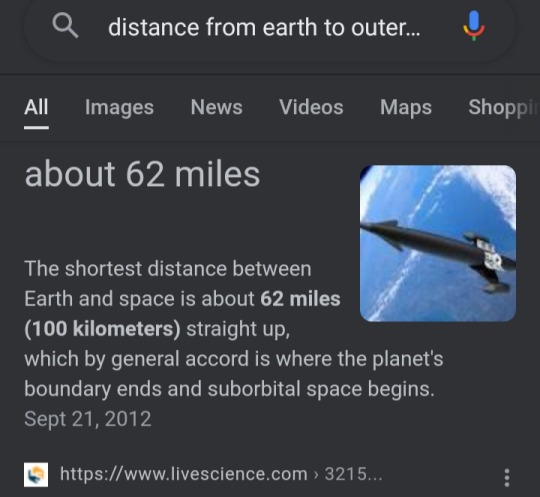
Huh. That seems.... not that far? What about...

Okay. Okay that's... still.... but maybe I'm seeing distances wrong let's try what the poster said
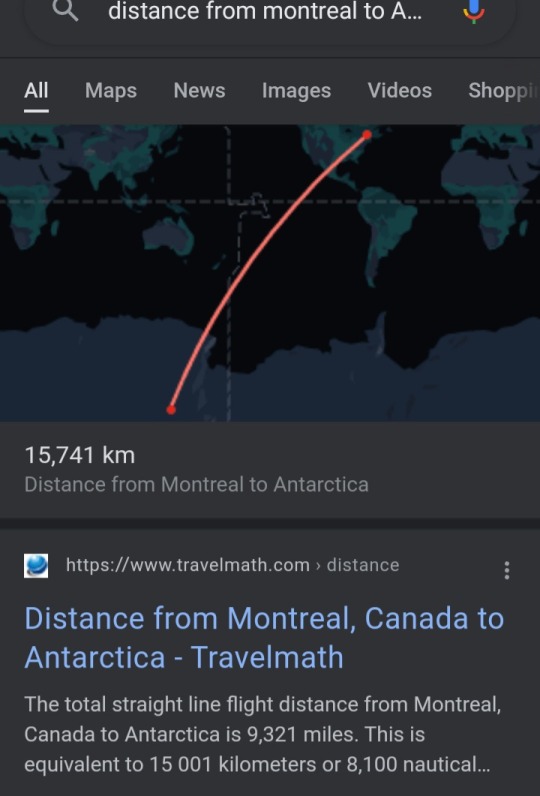
.....
Huh. That's. I'm. Wait what is...

Okay so the international space station is roughly 10 times closer to me than the west coast is that's fine this is fine I'm fine what
#space#art#skylon#skylon is a very interesting concept for a spaceplane#it would use a hybrid jet/rocket engine called the SABRE#SABRE would function as an air-breathing jet engine inside the atmosphere#then switch to an internal liquid oxygen supply when the air gets too thin at high altitude#this would allow Skylon to take off and land on runways like a regular jet plane#and not need a special launch pad or disposable booster rocket like other spacecraft#I hope it gets built someday - it would be cool to see it fly
86K notes
·
View notes
Text
Psycho-pass Movie Novel Chapter 7 Complete
Note before reading: sentences in italics represent the character’s thoughts; sentences between square brackets are phone/radio conversations or the voice of dominators or other electronic devices.
1
Among Desmond’s mercenaries was Bun, a dark-skinned Thai with chiselled features. He wore a jet pack with wings and an engine on his back, allowing him to move by jet propulsion.
As a sniper, Bun needed to always move into a dominant position. To do this, he used a high-performance, hydrogen-powered jet pack. It was a hybrid version that also supported compact batteries, which could be replaced by cartridges.
With sniper Bun’s offensive, the raid went from stealthy to dynamic. Bun, who was flying, landed on the top of a hill overlooking the group of ancient ruins. He was carrying a huge sniper rifle, using the jet pack on his back as a rifle rack. A sighting system with magnified holographic display — to receive information from Yulia — and semi-automatic firing of 20 mm armour-piercing incendiary rounds.
After the dull sound of bullets piercing through the armour plates, the guerrilla’s technicals[1] exploded with a burst of flames.

The sniping signalled the start of a simultaneous attack.
Rutaganda broke into the base with surprising dash power, guiding two attack helicopter-type drones via brainwave control. Even if the opponents were poor guerrillas, the level of difficulty of the operation was completely different with or without air cover.
It’s not as if he had a semi-mechanised body for show. Rutaganda could run 100 metres in about six seconds and jump up to five metres at a time with a running start. He made the most of these physical abilities, using them to climb over the walls of the ruins and penetrate the depths of the base.
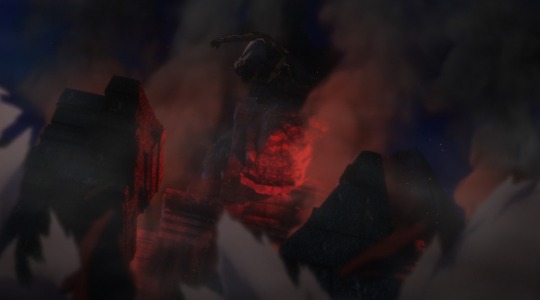
The mercenary soon spotted the guerrilla electronic warfare vehicles, which were loaded with modified ECM pods — a cutting-edge model used by the Japanese Border Defence System Air Force. These devices may have been removed from a fighter aircraft crashed for an incident or stolen — either way, the guerrillas would not have been able to handle such high-tech equipment without the tactical advisor in question. Nicholas’ government forces had suffered greatly as a result.
Guerrilla engineers and their guards had gathered around the vehicle to activate the ECMs. Rutaganda, holding a compact assault rifle, a carbine model, fired a short series of rapid shots. Bursts of fully automatic fire, separated by finger control. Two to three bullets were fired each time he pulled the trigger. By the time the magazine of 30 rounds was empty, there would be exactly 10 dead bodies.
The reinforced exoskeletons piloted by Weber and Babangida destroyed the barricade the guerrillas had built.
Machine guns and rocket launchers roared, blowing away guerrillas who had recognised the gunfire and jumped out of the way. Dozens of them were reduced to pieces of blood and flesh all at once.
[Bun, you too, over here.]
Rutaganda radioed.
“Roger.”
Bun, in the middle of his sniping task, took flight with his jetpack strapped to his back. Looking down on the entire village from above, he continued to fire his sniper rifle, supported by his robotic arm.

A small number of guerrilla fighters took out RPG-29 anti-tank missiles, which would have destroyed the reinforced exoskeletons in a direct hit. But the soldier holding the RPGs became the target of Bun’s sniper fire. The incendiary armour-piercing rounds he was using not only penetrated the enemy but also set them on fire. They could shatter bodies or make huge holes in them and set people on fire.
2
Kougami and Tsunemori run through the base of the disoriented resistance forces. Shacks and arms depots were blown up by machine gun fire from the attack helicopter-type drones. The men of the resistance forces first allowed women, children and the elderly to take refuge in caves.
“This way of doing things is different from those we have dealt with before!” Kougami said in a loud voice.
“How is it different?” Tsunemori asked.
“They aren’t relying on drones. They’re highly trained special forces. I’ve got a bad feeling about this.”
The two of them emerged into the square of the ancient ruins complex. From there, a road led in several directions.
Sem raced towards them in a military jeep.
“Sem! The ECMs?”
“They’ve been blocked! The enemy got ahead of us!”
It was then that Kougami realised the situation. After careful reconnaissance, the enemy had launched a surprise attack. Those guys have more advanced equipment than the government forces. As close to the ���Japanese army’ as possible — something the resistance forces had not expected.
“Sem, we’ll have her escape. Back me up.”
“Kougami-san!?”
At Kougami’s words, Tsunemori’s eyes widened.
Sem gave a nod and got out of the jeep.
Kougami asked Tsunemori to get in instead.
“You need to leave without me.”
As he was saying this, Kougami was handed an assault rifle and a grenade launcher by another guerrilla.
The man, who had been on the verge of sleep earlier, was carrying only a revolver for self-defence.
“I’m not leaving alone!”
“Your criminal investigation may lead us to catch Han for his crimes. It’s an opportunity for us. Return to Shambala and continue your mission.”
“But…”
“Don’t worry. Do you think I would die so easily?”
As he said this, Kougami wore a smile on his manly face.
“If we both survive this, come and catch me again.”
“…sure!”

Sem handed Tsunemori an electromagnetic pulse grenade.
She took it, glanced back and got into the jeep.
Kougami started running with Sem.
After separating from Tsunemori, Sem took his motorbike. Kougami and Sem, riding fast together on the bike, headed for the vehicles with the ECM pods. First, the helicopter-type attack drones above them had to be eliminated, or they wouldn’t have been able to counterattack or retreat. Had they been able to activate ECM, they could have disrupted the enemy’s coordination through communication jamming[2], noise jamming[3] and deception jamming[4].

Instead, huge machine-gun rounds rained down on the two men as they moved. They were from Weber and Babangida’s powered suits. For the moment, they had no choice but to flee. Kougami, who was driving, tilted the motorbike and quickly changed direction with an accelerated turn. He tried to get as far away from the powered suits as possible. But as soon as he slowed down to change direction, Sem, who was riding behind him, jumped off.
“Go! Kougami.”
“Sem, come along!”
“I can’t abandon a friend!
“Tsk!” Kougami clicked his tongue — Stop, you’ll die.
Sem. You’re not the type to die here.
Kougami rode the motorbike, worried, and eventually braked in the middle. He got off the bike and prepared the grenade launcher.
He didn’t make it in time.
Along with other soldiers fighting back, Sem was hit by a machine gun shell. With one shot, most of his upper body disappeared. No need to check, it was instant death.
“Sem…!”
— Such a man eliminated so easily!
Kougami shook with anger and clenched his teeth.
This was no time for shock.
He aimed the grenade launcher at the powered suits — .
At that moment, a moving antenna like a ‘scorpion tail’ attacked. Despite its name, it was almost as strong as steel and had a sharp hook at the end. Unable to dodge it, he quickly blocked the hook with his weapon.
“Thwap!”[5]
The grenade launcher was destroyed by the scorpion tail.
Yulia, dressed in a stealth suit, appeared in front of Kougami with a knife at the ready.
— Why doesn’t this female mercenary shoot me, even though she has a gun?
Kougami wondered as he dodged the knife attack by striking her wrist with his palm heel. If she has a weapon, she wouldn’t normally try to fight in close combat.
Then he realised — Maybe the order was ‘Don’t kill the Japanese’.
Kougami jumped back and paused, trying to use his assault rifle, which hang from a sling, but Yulia broke in earlier. To push her away, he hit her with a front kick, stamping with the back of his foot.
The woman dodged his front kick and swung her knife in a half turn. Kougami dodged the attack by lowering his head and countered with a low turning kick. Yulia used her shin to parry the lower kick and promptly kicked backwards.
Kougami bent his upper body to avoid her powerful move, then held Yulia’s knife-holding arm with his left hand while delivering a single backfist with his right.
Yulia deflected it with her left forearm.
— She is no ordinary woman.
In terms of fistfights, it was rare for Kougami to find an opponent he couldn’t defeat with that number of moves.
(... Have the government forces spared no expense in hiring a group of top soldiers?!)
Kougami couldn’t hide his surprise that such a unit would be working on a freelance basis.
3
Bun repeatedly shot from above while flying with his jetpack.
He reported by radio.
“Target Delta sighted. Should I fire?”
Delta — the code name for Kougami Shinya.
[Wait] Rutaganda’s voice said from the receiver. [What about target Juliet?]
Juliet — Tsunemori Akane.
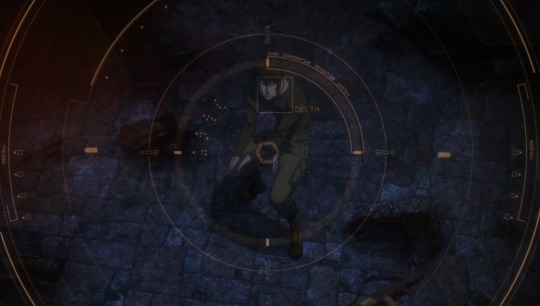
Tsunemori was sitting in the passenger seat of the military jeep driven by a middle-aged guerrilla. When the helicopter-type attack drones approached, she did not hesitate to use the electromagnetic pulse grenade. The explosion of the electromagnetic waves sent sparks flying from the drones. One crashed, but the another held on. Tsunemori moved to the rear of the jeep and unlocked the safety of the heavy machine gun mounted on the vehicle. The fusillade of 14.5 mm rounds blew off the second aircraft as well.
[She got me. She’s getting away.]
Rutaganda said.
“Juliet, do you want me to chase her... ?”
[No, it’s too late. Go after Delta instead. I’ll be right there.]
Bun detached his jetpack and landed directly in front of Kougami, joining Yulia in a two-on-one battle against the Japanese.

The Thai man fell from the sky, his face close to his shoulders, his jaw protected, a high stance. A Muay Thai[6] fighter, recognisable at a glance. The moment he touched down, he filled the gap and delivered a kick. A powerful kick — the Dtae Kan Core[7] (high kick), which is swung raising the pivot heel.
Kougami parried it with his forearm.
Matching the timing, the Russian woman delivered an oblique kick. Kougami blocked the kick with his shin and returned it with a jab.
Not only were they well equipped with high-tech gear; they were also well trained from head to toe. A Thai man and a Russian woman, a good combination.
He dodged the Russian’s knife and elbow-striked the Thai. The attack and defence continued without the slightest distraction.
It’s rather good, Kougami thought. I appreciate enemies who deliberately challenge me to a fight, no matter how tough they are. Now that I know the other side wants to catch me alive, I can take more risks. Once these two are defeated, I’ll have my way…
“Ugh” Kougami landed a front kick to the Russian woman’s stomach.
Hit in the gut, the woman was blown away.
The Thai then punched him to cover her. Reading the attack, Kougami grabbed the Thai's neck and elbow, locked him in a joint lock and threw him to the ground.
The Thai hit the Russian woman Kougami had just knocked out. The two were tangled together, exposing the back of their heads, completely vulnerable.
The next moment, Kougami lifted his leg — to trample them down and deliver the final blow.
“Tsk!”
A large man rushed in from the side with incredible speed.
Rutaganda also attacked Kougami.
Yulia and Bun were two, and yet they were about to lose. He was secretly impressed and wondered if such an incredible man existed. That’s awesome!
— I LOVE GUYS LIKE YOU!
Bun, who had been thrown to the ground, was about to be kicked in the back of the head when Rutaganda intervened. Kougami had good instincts and jumped back quickly when he sensed the danger. Rutaganda kicked the ground and took another step forward.
Close combat.
After a quick punch with his human left hand — which he deliberately allowed Kougami to block — he unleashed his likely winning right hook. Rutaganda’s right arm was made of a special alloy. Kougami caught this right hook with his left arm.
Rutaganda blew him away with his entire guard.
“!”
With a deep groan, Kougami rolled to the ground.
Rutaganda went after him.
Kougami stood up and delivered a spinning kick in the style of capoeira.
At the critical moment, Rutaganda stopped the kick with his elbow.
(It was quite something to kick back from that position.)
Rutaganda grabbed Kougami’s wrist. It was difficult to take the joint. Kougami then shook off Rutaganda’s joint lock technique and turned it into an elbow joint. — A mistake on Kougami’s part. He must have instinctively returned the joint lock to the opponent. Rutaganda’s right arm wasn’t that easy to break. Kougami’s movement stopped when he failed to overcome the special alloy prosthetic arm.
Rutaganda delivered a low kick with his left leg, which, like his right arm, was made of a special alloy.
The strong kick overturned Kougami.
Kougami hit the ground with his back. Finally, there was an opening.
Rutaganda grabbed Kougami’s neck with his right hand, then put his knee on Kougami’s stomach and started pressing.
“…You’re quite something.”
“If you let me live, you’ll regret it…!”
“Terrifying. Unfortunately, we have some important questions to ask you.”
Squeezing his carotid artery, Rutaganda easily knocked Kougami unconscious.
4
— The enemy’s pursuit seemed completely forgotten.
Having separated from the guerrilla soldier who had been her driver, Tsunemori was now driving the military jeep alone. She crossed the forest, running fast on the bad roads to the glittering Shambala Float.
“The gunfire has stopped…”
The fight was over.
Who won? In this situation, the result was obvious.
Tsunemori had a faint expectation that Kougami would go after her with an innocent air, but that seemed a little too optimistic.
— No matter what, Kougami Shinya is not the type to die in a place like that. Somehow, I can be sure of that. Of course, I can’t shake off the anxiety. There are no ‘absolutes’ in the field where lives are at stake. I just want to believe that he will be all right. To think that we were separated like that in Japan, reunited after so many years, and then immediately separated again in combat — .
“Kougami-san…”
She murmured involuntarily, as if praying.
NOTES TO TRANSLATION:
[1] Technical is a neologism for a non-standard tactical vehicle (NSTV) in United States military parlance, a light improvised fighting vehicle, typically an open-backed civilian pickup truck or four-wheel drive vehicle modified to mount small arms, light weapons and heavy weaponry, such as a machine gun, automatic grenade launcher, anti-aircraft autocannon, rotary cannon, anti-tank weapon, anti-tank gun, anti-tank guided missiles, mortar, multiple rocket launcher, recoilless rifle, or other support weapon (somewhat like a light military gun truck or potentially even a self-propelled gun). (from Wikipedia)
[2] Communication jamming: An attack that attempts to interfere with the reception of broadcast communications.
[3] Noise jamming: It’s the simplest form of jamming that works by overwhelming the target radar with a large amount of noise, making it very difficult to find any actual radar returns within the cone of effect.
[4] Deception jamming: Deception jamming is an electronic warfare technique that aims to fool radars into believing that the target is in a different location than it really is, or that there are more targets than there really are.
[5] Thwap: a loud, heavy, slapping impact or the sound made by such an impact.
[6] Muay Thai: martial art also known as Thai boxing, characterised by stand-up striking, sweeps, and various clinching techniques.
[7] Dtae Kan Core: this muay thai move is also called high kick or kick to the neck. (from Thai Boxing Terms)
translation by cleverwolfpoetry @ https://cleverwolfpoetry.tumblr.com/
PLEASE, NO REPOSTS OUTSIDE OF TUMBLR.
#psycho pass translations#kougami shinya#tsunemori akane#psycho pass the movie#gekijouban psycho pass#chapter 7
29 notes
·
View notes
Text
TF2 x JP/JW
Team Fortress 2 x Jurassic Park/World AU (DINO version) Pt.3
Gravel Wars turn into… Dino wars, two teams fighting in enclosed areas for human entertainment - and Especially for scientists to analyze the behaviors and strengths of the ancient beasts.
"Welcome to Mercenary Park!"

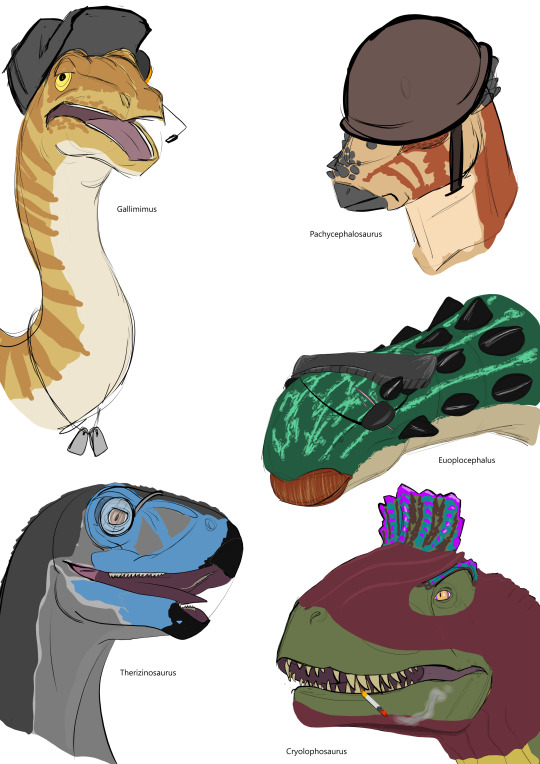
what each class represents (but not necessarily limited to):
Sniper : Spinosauridae / Australovenator
Heavy : big dino
Engineer : Ceratopsidae
Pyro : Any dino/hybrid that can wear a mask
Scout : FAST AS FOK
Soldier : Pachycephalosauridae
Demoman : armored
Medic : Therizinosaurus… Idk
Spy : fancy looking dino / Iguanodon / Deinocheirus
alternate glasses, Spy mask & skin + Demo's eyes:
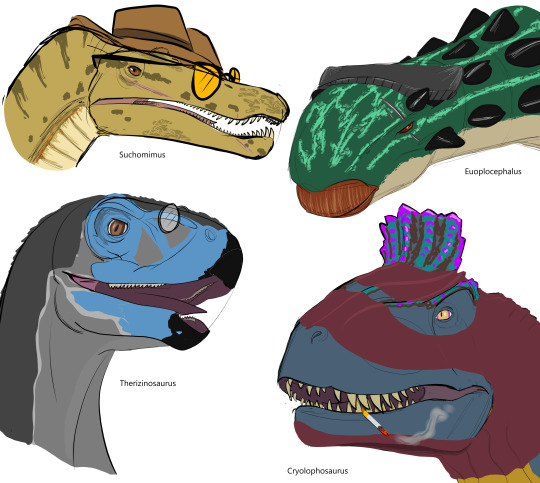
RED and BLU teams have different dinos – e.g. RED Scout is Gallimimus and BLU Scout is Velociraptor (Except both Medics are Therizinosauruses but they do look different).
Initial idea was that the RED team's counterparts (BLU) were scientifically accurate dinosaurs. I'm leaning more towards to the idea that all mercs can be drawn to look more scientifically accurate if wanted. But whatever, it's not serious stuff: it's all about bone headed Sollys rocket jumping into the moon to capture the flag.
main references: Jurassic World Evolution games & JW:Dominion
#tf2#team fortress 2#tf2 au#tf2 crossover#tf2 fanart#jurassic park#jurassic park fanart#jurassic world#jurassic world fanart#tf2 scout#scout tf2#tf2 spy#spy tf2#tf2 heavy#heavy tf2#tf2 medic#medic tf2#tf2 demoman#demoman tf2#tf2 sniper#sniper tf2#tf2 soldier#soldier tf2#tf2 engineer#engineer tf2#tf2 pyro#pyro tf2#tf2 mercs#jurassic park au#dinosaurs
197 notes
·
View notes
Note
Any RPGs about being an unethical mad scientist or being a mad scientist's creation? Like creating an orangutan with buzzsaws for hands, a horribly mutated two-headed crocodile, grafting a rocket launcher onto a demon's back, giant biomechanical monstrosities, etc.
THEME: Mad Scientist’s Paradise
Hello, so I have a few games that seem specifically tied to mad science, but I also found some games about mutant animals that are a bit more focused on a post-apocalypse. I hope they are still close enough to what you are looking for!
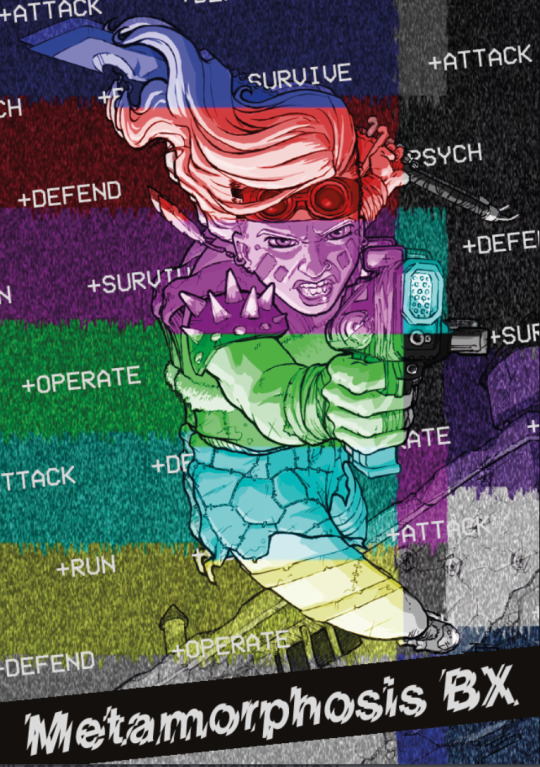
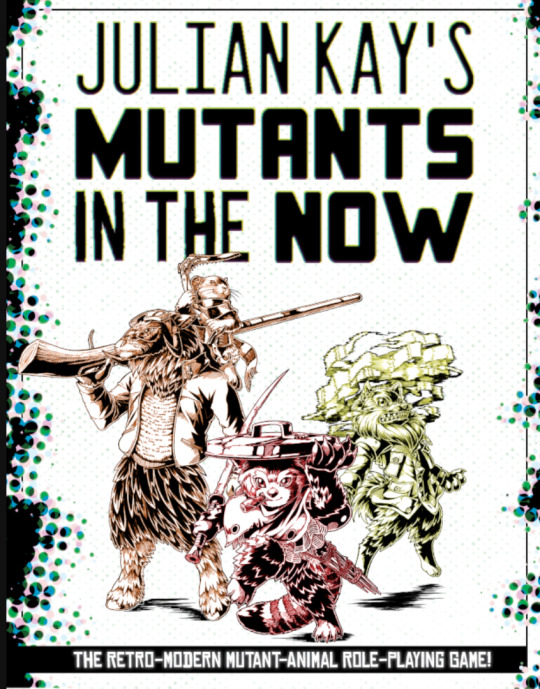
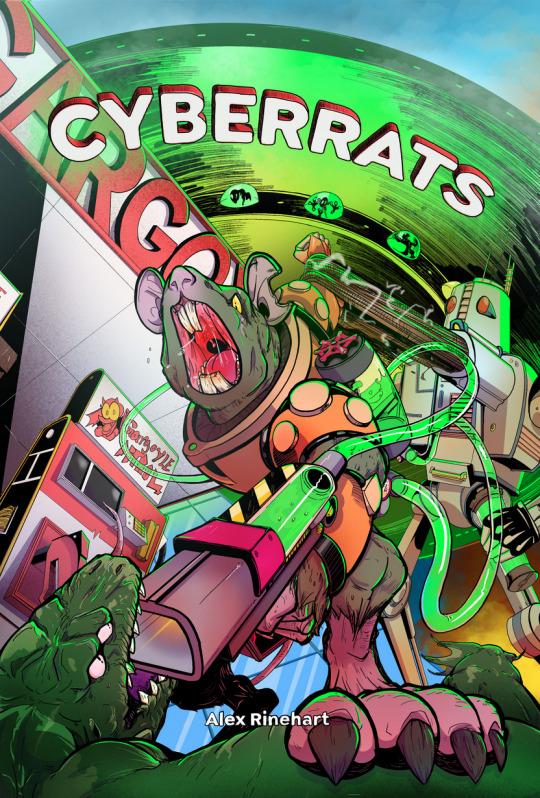
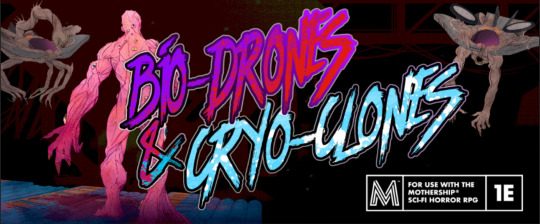
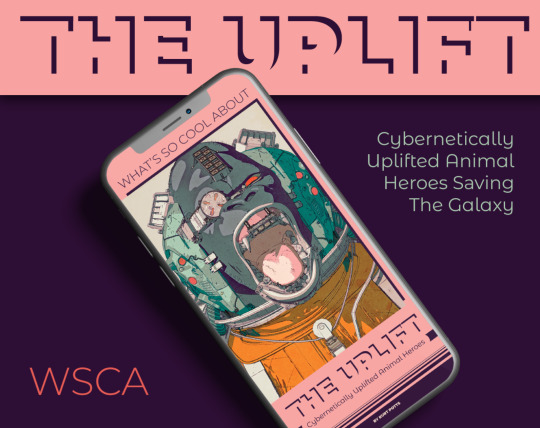
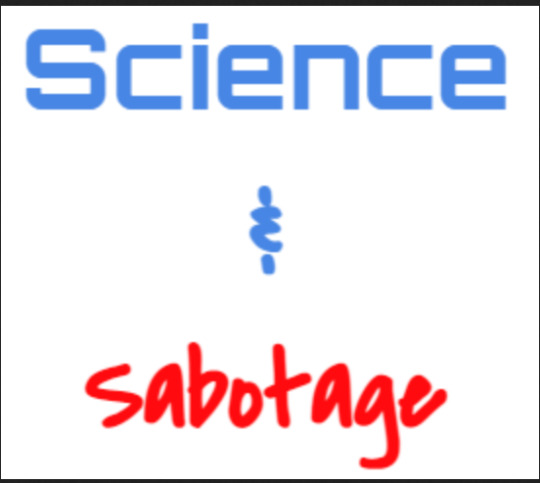

Metamorphosis BX, by Tragos Games.
Metamorphosis BX is a post-apocalyptical MiniBX hack in which you'll roleplay a hybrid survivor in an ever-changing world in which a cataclysm fragmented time and space. It is light both in mechanics and tone, aiming to be fun above all.
This is one of the games where your strange mutations and abilities don’t necessarily come from mad science; but I think they could, if you wanted them to. This is a game that employs the use of roll-tables and gives your characters both benign and malign mutations, with different sized pools of different size dice for your hit dice. What is interesting is that you have a list of different dice pools on what is called your hit dice double-helix, aka HDDH - taking your highest dice from your dice pool every time you take a hit. This encourages your characters to end fights quickly, or avoid them when you can - and it also makes for a highly lethal game.
Mutants in the Now, by Julian Kay.
In the ‘80s and ‘90s, they ruled the streets, kick-flipping off of villainous faces and slipping into the shadows. Then, they vanished from the world of tabletop gaming.
But they’re back. And ready to KICK BUTT.
Mutants in the Now is a retromodern retake on the mutant animal role-playing games long past and left behind by licensing. Mutants fight to survive, thrive, and make the world better for themselves and humanity.
I’m not entirely sure what the origin of your mutation is in this game, and it seems that’s the point. The source of your mutations is meant to be a mystery, although big tech corporations, alien conspiracies, and psychic ninjas are all on the list of potential bad-guys. The game itself has a multitude of good reviews, with a lot of praise for the flexibility available to you at character creation, and a large amount of love for the random tables.
If this game sounds interesting but you want something a little less scienc-ey, you might also want to check out the Mutants in the Next supplement, which adds in cryptids, mythical beasts, and a post-apocalypse setting to throw at your characters.
CyberRats, by Alex Rinehart.
You are genetically engineered Operatives addicted to Biotech, a glowing gel that gives you superhuman powers.
The world is being invaded by extraterrestrials known as Interlopers. You have been employed by a megacorp to ensure that the aliens don't win, and that if they are stopped, it's you who does it, and not some rival corporation.
Winning won't be easy. But it also won't be enough. The right corp must get credit.
Can you stop the aliens? Will you sabotage the military to steal equipment and defense contracts from your competitors? How many Operatives will you lose before you taste victory?
Cyberrats, an illuminated RPG.
Here’s a game all about being lab rats - literally! Cyberrats is a fast-paced shoot-em-up about genetically engineered rats addicted to the substance that gives them super-human powers, up against a terrifying alien threat. Your characters can be altered biologically, but also cybernetically, so I have a feeling rocket launchers and exo-suits are on the table here!
If you want to hear what this game plays like, you can check out the Cyberrats Radio Hour, a 30-minute episode full of alien combat and explosions.
Bio-Drones & Cryo-Clones, by ChrisAir.
Bio-Drones & Cryo-Clones is a 48pg biopunk facility-crawl for Mothership RPG, inspired by the body horror of Cronenberg’s The Fly and a twisted take on Metroidvania “save stations.” This zine is the first installment of The Sleeper Crew Adventures zine series.
PCs wake up in the Mountain Forces R&D Facility, dropped smack center into the plans of a scientist gone mad in her love for the dead despot that once owned the world. Players must gather clues, navigate NPC motivations, evade monstrosities before they Become the Mutants.
This is less of a gonzo scenario and more built for fans of horror, putting the player characters in a hostile lab environment and threatening them with a number of mutations as they try to find a way to stop the mad scientist big-bad of the adventure.
This isn’t a standalone game, but rather a module for Mothership, which is a game set inspired by Alien and has many, many different kinds of modules that you can run in many different horror scenarios. This module looks rather extensively developed, with printable maps, a set of VTT tokens, and art for all of the listed NPCs and Creatures. If you want a game full of suspense and horror, you should check out Bio-Drones & Cryo-Clones!
The UPLIFT, by Kurt Potts.
The Uplift is a tabletop RPG about cybernetically uplifted animal heroes saving the galaxy with superpowers! Think Guardians of the Galaxy, but you're all playing Rocket.
You awaken to find you are both less and more, you are both old and new.
You play animals who've been cybernetically uplifted by some mysterious company or lab. Through your adventures you may get the chance to learn why this was done to you, but by then it may not matter anymore. You're a hero and the galaxy needs saving.
Describe yourself in four steps, and let the GM describe to you the situation the crew finds themselves in. You roll 2d6 for pretty much everything you try, with modifiers for advantages and disadvantages. Each character will have one super-power that allows you to add a third d6 to certain rolls, to increase your chance of beating the difficulty score. You can risk personal injury or busted implants on a failure, and then spend downtime later to fix yourself up.
I like that the designer of this game took the basic rules of WSCA games and combined them with tools like clocks and downtime, which are commonly seen from Forged in the Dark games. It allows the players to deal with bigger setbacks during play, because you know you’ll have a chance to fix them down the road. That being said, you can still choose to die a heroic death if you still want to!
Science & Sabotage, by Live Real Press.
You are a team of evil mad scientists, hell-bent on creating a doomsday device that can bring the world to its knees.
Unfortunately, there is competition for the honor. You must finish your device before they finish their device.
You don't have time to play fair.
This is a game where you actually get to play the mad scientists, rather than their creations. It’s built off of the famous Lasers & Feelings structure, so you just need a d6 or two to play. Race against a rival team of mad scientists to be the first one to destroy the world - or at least, to threaten the world with destruction. This is probably good for a single one-shot, or perhaps, if you want to combine it with one of the other games here, you might want to use this game as a set-up for the event that destroyed the world, or perhaps your scientists are instead racing to be the first to cause mutations on a global scale!
Blister Critters, by stillfleet.
Pick your favorite varmint, grab your dice, and roleplay as a cartoon animal on a radiation-blasted Saturday-morning show!
The humans are gone just like the ozone layer, and the world they left behind is overflowing with danger…
In this innovative and surreal game, you play as a small animal who can wield bizarre mutations called Blisters as well as physics-bending Nonsense powers. These strange abilities—artfully developed within the Grit System—will help you survive in a vast, cruel suburbia populated by fellow Critters and their feral counterparts, Beasts.
The sun will mutate you and give you special powers as you scavenge the piles and piles of loot that the humans have no more use for. The tone of this game is very much like a Saturday-morning cartoon, but you can also turn up the gritty dial and make it about the harshness of this new world if you want to. Blister Critters uses a number of different polyhedral dice, with larger dice assigned to traits you’re good at and smaller dice assigned to traits you’re… not so good at. Your character also has two pools that can diminish: Health and Grit, which represent your hit points and your energy respectively. Your Grit can be spent to power the special abilities given to you by your Blisters, so the course of gameplay will likely require balancing your resources as you work through various obstacles.
The Kickstarter has finished for this game, but you might want to keep an eye on it so you can see when the final product is published. In the meantime, you can also check out the Quickstart, as well as the entries to the Critter City Crawl Jam.
84 notes
·
View notes
Text

We open Womens' History Month 2025 with a study of the life of Annie J. Easley (neé McCrory). Born in 1933 Birmingham, Alabama, Annie showed a strong aptitude for chemistry and pharmacy and graduated from high school as valedictorian, but after she married in 1954, she took a job as a mathematics teacher in Birmingham. One of her quiet-but-determined goals in that role was to prepare members of her community for deliberately-challenging literacy tests that were part of the Black voter experience (see Lesson #166 for more on this shameful trend).
In 1954 she and her husband Theodis Easley moved to Cleveland, Ohio where she resumed her pharmacy studies, but was again pulled away by another opportunity --this time at the Aircraft Engine Research Laboratory (an agency that would later be incorporated into NASA). Annie's innate math skills got her in the door and led to a 34-year career as a computer scientist. One of only four Black employees at the entire project, Easley's first significant contribution was on the computer research team that calculated the trajectory needed to get Friendship 7 to orbit in 1962. Later she joined the simulations team at Plum Brook Reactor Facility and worked on the Centaur booster rocket --a project which itself led down a path to calculating long-term damage to the ozone layer and proposing new alternative fuels (and the earliest prototypes for what are today known as hybrid vehicles). Without having ever formally earned a college degree, Easley taught herself FORTRAN (still a new programming language at the time!), and then SOAP (Simple Object Access Protocol).
In 1977 Easley took a bit of time away from rocket science to earn her degree in mathematics, from Cleveland State University. During this interval she worked as a tutor and encouraged young Black students --particularly girls-- to consider a path in STEM. She then promptly got right back to work and continued with NASA until 1989. Towards the end of her career she also worked as an Equal Employment Opportunity (EEO) counselor, addressing discrimination complaints within the agency --no stranger to discrimination herself, having once had her portrait cropped out of a formal group photograph of the Lewis Flight Propulsion Laboratory programming team.
For further study: a rich, in-depth interview with Easley by Sandra Johnson in 2001 (this is a NASA.gov website --therefore it might not be a bad idea to copy the entire text of this article and save a version for yourselves, to share with others. Posterity is... not presently being kind to stories like these.)
#black history#womens history month#hidden figures#nasa#friendship 7#stem#teachtruth#dothework#showup
17 notes
·
View notes
Note
hello airplane enjoyer. i am curious about your thoughts on the design of the God Phoenix from Gatchaman? the old one that fucks, not the new one
Ooh, plane anon. Alright, never heard of that plane or that show before, so let me do a little searching...
Oh.
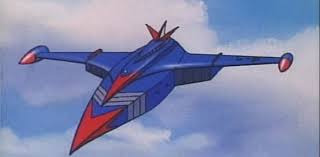
Well that's definitely a plane for sure.
Only one pair of main wing and... somehow 3 vertical(ish) stabilizers? I wanna see if there's a rear view, hold on.

Two engines, so that's pretty standard. I can't tell where this thing's cockpit is, if there is one. Assuming it's not a drone/UAV.
I'm not an aerospace engineer but realistically I don't think this sort of design will be able to fly irl, because the main wings are so far back and there's nothing on the front to generate lift like small canards. Which means all the lift will be at the rear, so the nose wouldn't be able to pitch up...?
I guess that depends on the weight distribution, like if 80% of the mass is at the back half of the plane. But I don't think that's likely here.
Those exhausts look... hm... pretty normal. You'd still find jet nozzles like that in current era jets. Wonder if that's capable of thrust vectoring too.
Those pencil shaped things on the wingtips look like fuel tanks, kind of like the ones on an F-104 Starfighter, so that's taken from reality as well.
I can't make out what it is with that triple vertical stabs arrangement thing, definitely unorthodox.
Actually let me just read the wiki page of this Gatchaman show, which, again, I've never heard of before. But that design definitely speaks 1970-1980 aesthetics.
HOLD UP

It's a vehicle carrier, a spaceship and a submarine at once?! The designers must had been on crack when designing it. This thing has to be honking massive.
I mean, it speaks 1970-1980 aesthetics, so I guess rule of cool is the number one rule here.

It can reach Mach 5 in plane mode and 40 kts underwater. I don't know what the second and third point means but the fourth point is a concern because... well I can't see how you would use jet/rocket hybrid when traveling underwater. But again, rule of cool.

Yeah it's got nukes, so it has to be honking massive. I guess now that I'm reading the weapon/armament section, it is more like a spaceship fighter. That can also... function as a submarine.
Definitely one of the vehicles of all time, I can tell you that much.
6 notes
·
View notes
Text

NASA Marshall fires up hybrid rocket motor to prep for moon landings
NASA's Artemis campaign will use human landing systems, provided by SpaceX and Blue Origin, to safely transport crew to and from the surface of the moon, in preparation for future crewed missions to Mars. As the landers touch down and lift off from the moon, rocket exhaust plumes will affect the top layer of lunar "soil," called regolith, on the moon. When the lander's engines ignite to decelerate prior to touchdown, they could create craters and instability in the area under the lander and send regolith particles flying at high speeds in various directions.
To better understand the physics behind the interaction of exhaust from the commercial human landing systems and the moon's surface, engineers and scientists at NASA's Marshall Space Flight Center in Huntsville, Alabama, recently test-fired a 14-inch hybrid rocket motor more than 30 times. The 3D-printed hybrid rocket motor, developed at Utah State University in Logan, Utah, ignites both solid fuel and a stream of gaseous oxygen to create a powerful stream of rocket exhaust.
"Artemis builds on what we learned from the Apollo missions to the moon. NASA still has more to learn more about how the regolith and surface will be affected when a spacecraft much larger than the Apollo lunar excursion module lands, whether it's on the moon for Artemis or Mars for future missions," said Manish Mehta, Human Landing System Plume & Aero Environments discipline lead engineer.
"Firing a hybrid rocket motor into a simulated lunar regolith field in a vacuum chamber hasn't been achieved in decades. NASA will be able to take the data from the test and scale it up to correspond to flight conditions to help us better understand the physics, and anchor our data models, and ultimately make landing on the moon safer for Artemis astronauts."
Of the 30 test fires performed in NASA Marshall's Component Development Area, 28 were conducted under vacuum conditions and two were conducted under ambient pressure. The testing at Marshall ensures the motor will reliably ignite during plume-surface interaction testing in the 60-ft. vacuum sphere at NASA's Langley Research Center in Hampton, Virginia, later this year.
Once the testing at NASA Marshall is complete, the motor will be shipped to NASA Langley. Test teams at NASA Langley will fire the hybrid motor again but this time into simulated lunar regolith, called Black Point-1, in the 60-foot vacuum sphere. Firing the motor from various heights, engineers will measure the size and shape of craters the rocket exhaust creates as well as the speed and direction the simulated lunar regolith particles travel when the rocket motor exhaust hits them.
"We're bringing back the capability to characterize the effects of rocket engines interacting with the lunar surface through ground testing in a large vacuum chamber—last done in this facility for the Apollo and Viking programs. The landers going to the moon through Artemis are much larger and more powerful, so we need new data to understand the complex physics of landing and ascent," said Ashley Korzun, principal investigator for the plume-surface interaction tests at NASA Langley.
"We'll use the hybrid motor in the second phase of testing to capture data with conditions closely simulating those from a real rocket engine. Our research will reduce risk to the crew, lander, payloads, and surface assets."
Through the Artemis campaign, NASA will send astronauts to explore the moon for scientific discovery, economic benefits, and to build the foundation for the first crewed missions to Mars—for the benefit of all.
4 notes
·
View notes
Text

Annie Easley for NASA Science & Engineering Newsletter (1981)
Born on April 23, 1933, Easley was an African-American mathematician, rocket scientist & computer scientist. She worked at NASA's Lewis Research Center & its predecessor, the National Advisory Committee for Aeronautics (NACA)
She was a key member of the team that created software for the Centaur rocket stage & was among the first African-Americans to serve as a computer scientist at NASA. She contributed to the development of technologies that paved the way for hybrid vehicles and worked on software essential for modern spaceflight.
Her thirty-four-year career at NASA involved creating computer programs focused on alternative energy solutions such as wind and solar power, energy conversion & vehicle batteries. She wrote and implemented code to study and analyze solar & wind technologies.
Easley also focused on identifying energy-conversion systems & determining the lifespan of storage batteries, significantly contributing to the advancement of batteries used in hybrid vehicles. Her work on the Centaur, a high-energy booster rocket, established it as the most powerful upper stage in the U.S. space program.
Her efforts aided the 1997 Cassini probe's mission to Saturn, which utilized the Centaur as its upper stage. The Centaur has been employed to launch spacecraft such as Voyager, Pioneer & Viking, as well as numerous communication and weather satellites.
19 notes
·
View notes
Text
Zones are complicated .-.
Traveller’s Log, March 19 2025- turns out Tumblr and similar platforms are multi-zonal/multi-dimensional, meaning any posts I make connect to possibly thousands of other zones making it virtually impossible to define my own home zone! So as a coping mechanism, allow me to quickly illustrate my zone’s timeline:
-> 1988, typical earth prime timeline, up until Dr. Julian Robotnik joins Sega as an underemployed software engineer for their new video game- he does not hit off with his coworkers and they eventually use him as inspiration for the main villain as an inside joke. -> 1999, Sonic Adventure- Dr. Robotnik goes missing, later discovered to have zone hopped by accident to the X zone. Due to a litany of time discrepancies to be explained later, he also ends up in the main Sonic universe.
-> 2003-2006, the typical sonic X timeline, ending with Christopher Thorndyke attempting to develop a zone-travelling portal. It’s important to note that the “shadow” Dr. Julian Robotnik comes across is N/A-20, an undisclosed clone hybrid of the main Project Shadow. -> 2012, Now Dr. Christopher Thorndyke finishes his portal and goes missing. The rocket at the end of season 3 fails, leaving Thorndyke stranded in the X zone, eventually and begrudgingly taking up an offer for apprenticeship under Dr. Robotnik to develop a way back home.
-> 2018 Under the moniker “Molly Turn”, I use my own zone-travelling abilities to locate N/A-20 to return him to the X zone, stranding myself there in the process. Due to my determination and pure stubbornness I ended up spending an inordinate amount of time around Dr. Robotnik and Thorndyke’s machines, before Christopher left and I somehow became Dr. Robotnik’s new apprentice (it is worth noting I was 10-12 at this time.
-> June 2018, or two years in the X zone, I got exiled to cyberspace after an attempt at zone travel, where I remain for (5 years on my end) 7 years. This is where the events of Chaotic AU occur.
-> 2024/25 after being detected by Sage during the events of frontiers, I was pulled out of cyberspace, mostly intact! That’s a lie I’m 67% inorganic now. Nonetheless, over the past several months I’ve pieced together my shattered psyche (a side effect of the cyberspace’s function as a search engine, it steals data from any “host” it acquires, hence the bouts of amnesia seen in the IDW comics seen with both Sonic and Dr. Robotnik. Another thing worth mentioning is how in our world, the energies cyberspace run off of are Phantasmic in origin, almost directly connected to the (missing, we’re working on it) phantom ruby and ironically the warp topaz, honestly people need to start at the very least figuring out what gem they are before giving them a name no matter how sick the said name is ;-;
2 notes
·
View notes
Text

Fortnite is an online video game and game platform developed by Epic Games and released in 2017. It is available in seven distinct game mode versions that otherwise share the same general gameplay and game engine: Fortnite Battle Royale, a battle royale game in which up to 100 players fight to be the last person standing; Fortnite: Save the World, a cooperative hybrid tower defense-shooter and survival game in which up to four players fight off zombie-like creatures and defend objects with traps and fortifications they can build; Fortnite Creative, in which players are given complete freedom to create worlds and battle arenas; Lego Fortnite, an open world game collection divided between survival game Lego Fortnite Odyssey and social game Lego Fortnite Brick Life; Rocket Racing, a racing game; Fortnite Festival, a rhythm game; and Fortnite Ballistic, a tactical first-person shooter currently in early access. All game modes except Save the World are free-to-play.
#911 abc#agatha harkness#bucktommy#batman#artists on tumblr#agatha all along#anya mouthwashing#cats of tumblr#dan and phil#captain curly
2 notes
·
View notes
Text

New Corvette Has 1,063 HP,
Over 215 MPH
Corvette has blown past the 1,000-horsepower marker.
Chevy introduced its fastest, track-focused, 2025 ZR1 model Thursday with a twin-turbocharged, 5.5-liter V-8 engine that makes a stratospheric 1,064 horsepower — the first ‘Vette to hit quadruple digits. The number puts the mid-engine sportscar in elite, million-dollar-plus hypercar territory along with European rocket ships like the 1,063-horsepower Mercedes-AMG One and 1,160-horse Aston Martin Valkyrie. Yet the Corvette will cost a tenth of these exotics at an estimated $150,000 when it goes on sale this fall.
The staggering power number is the highest-rated V-8 made by any automaker. It raises expectations that the hybrid-electric, all-wheel-drive version of the eighth-generation (C8), mid-engine car — reportedly called the Corvette Zora, may approach 1,500 horsepower — eye-watering territory occupied by exotics like the Bugatti Chiron Sport.
“We are looking to connect with Ferrari and Lamborghini customers with these performance numbers,” said Harlan Charles, Corvette marketing manager. The ZR1 was introduced at an event in Miami, but The Detroit News got a preview of the car with its product team in Sterling Heights earlier this summer.
Impressively, the ZR1 puts its 828 pound-feet of torque to the ground with same 8-speed transmission and 13.6-inch, rear-wheel-driven tire setup as the 670-horspower Z06, the fastest, normally-aspirated Corvette ever made. Strap twin turbos on the race-developed, screaming, 5.5-liter, overhead cam V-8 (internally referred to as the LT6) in the Z06, and Chevy engineers achieved hypercar power numbers with a redline of 8,000 RPM.
While performance numbers have not been finalized, Chevy says the ZR1 has a top speed of in excess of 215 mph and will blow through the quarter mile in less than 10 seconds.
5 notes
·
View notes
Note
Question for Peach
If a Mewtwo hybrid has DNA from a Pokemon that can't mega evolve, would the hybrid itself be able to?

Peach: Theoretically, Yes. The chances of them being Unable to mega Evolve is actually significantly low.
Peach: The Mega Stones that are out there- that were created- are tied to very specific strands of DNA and forewent the 3rd strand.
Peach: It ties closely to the Mew portion of our DNA- How it was created, i'll never understand- but in that sense it's locked to that portion and that portion alone.
Peach: Ive never seen a Mew, Mega Evolve- Not sure if they could if they were given a Mewtwo Mega Stone- BUT I do know that Ash and Indigo can mega Evolve ONLY with the Mewtwo Mega stone.
Peach: Ash has a Lucarionite, Given that he has a strand of Lucario in him, He SHOULD be able to Mega Evolve. But it simply does not Regiater Ash's Lucario portion- whether that be a mix of DNA or not, i don't know.
Peach: But MY Spare Mega Stone does react to him- if it were only locked onto my strands of DNA wouldnt that prevent Ash and Go from evolving as well?
Peach: Its an interesting concept. All of us were engineered by Team Rocket- techncially speaking- We werent created to have a stronger form, so this has to do something with Nature itself but uh.
Peach: Its confusing to say the least...
17 notes
·
View notes
Text
Eastward thoughts (spoilers)
It’s interesting how Earth Born becomes an echo of Eastward. Things like the princess in the tower, and the repetitive nature of the game mirrors the constant destruction/and rebirth that’s happening in the world because of the miasma.
Guy, from the original Rocket Knight Legion, created the Earth Born game. I’m not sure if this means the game is meant to create a mythology that affects the culture of the people in the world (and encourage someone to bring a clone of mother to the tower?)
I’m not Chinese or Buddhist but I’m sort of assuming that’s some of the stuff with Alva’s Buddha hand fans and trying to cure the Miasma- it’s about trying to find an end to the cycle of life and death. (Could be totally wrong though.) Trying to understand the story through the lens of a reincarnation allegory at least feels like it’s helping me process some of the themes.
I’m assuming the Monkollywood monkeys are from an original experiment to genetically engineer lifeforms? This might also be why so many animals in the world are bizarre hybrids. Did Solomon film the Earthborn show with the Rocket Knights? And the old monkey who played the monkey on the show was one of the first intelligent monkeys, and possibly because of his experience on the set he’s born a culture of filmmakers?
In general, re: Earth Born, I like when fictional worlds have their own fictional pop culture and mythology.
Memory and repeating cycles are such major themes in the story. I wonder if the fridge was meant to help mother get her memories back.
Is Frank of the Rocket Knights an experiment as well? It sounds like they were investigating immortality. (I don’t think he is the same as a miasma zombie but I have no idea.) Frank’s codename is cleric because Clerics can revive the dead.
After the Miasma wipes a town out, does the human factory repopulate the area? And Charon delivers the Miasma?
I still think it’s cool how John is represented by the frying pan - something he uses offensively and uses to nurture. John is all about acts of service.
They did Alva and Isabel dirty.
I’m still really moved and disturbed by Greenberg. I think the game did an incredible job of making this location impossibly dreamy and charming. I was so invested in the community drama of trying to set John up with Uva. The ending was devastating, and made me genuinely tense to enter any of the other factories. I think it was a powerful choice to have something like this upfront- it establishes a dark tone, and forces us into the story. And it gives such a punch to later scenes, like going to Old Town for the first time and seeing miasma zombies.
And I love how the currency was salt. I know how salt has been a currency in the past. I think it’s a great example of how focused the world is on survival. Currency needs tangible value.
I’m kind of disappointed with the ending tbh, maybe because of how I initially interpreted it? I dunno.
That’s all for now! I already started replaying the game.
17 notes
·
View notes
Text
[Video description: a video by @ bekireke that is captioned, "types of cat engines". Six cats are shown as they're being pet. A microphone records the sounds of their different purrs. In order, the cats are labelled, Petrol, Diesel, Hybrid, Electric, Jet, and Rocket. End description.]
kitty car 🐱
87K notes
·
View notes
Text

Using multimode propulsion for more efficient trips in space
Over the span of two projects, researchers at the University of Illinois Urbana-Champaign investigated using a propulsion concept known as multimode propulsion to get spacecraft to the moon and developed a technique to design optimal multimode transfers.
NASA provided the team with four real mission scenarios. The goal was to explore how a multimode propulsion system that integrates both a chemical high-thrust mode and an electric low-thrust mode—while using the same propellant—can succeed. They examined using a standard 12-unit CubeSat to accomplish four distinct missions.
"We showed for the first time the feasibility of using multimode propulsion in NASA-relevant lunar missions, particularly with CubeSats," said aerospace engineering Ph.D. student Bryan Cline. "Other studies used arbitrary problems, which is a great starting point. Ours is the first high-fidelity analysis of multimode mission design for NASA-relevant lunar missions."
The study that looked at four NASA-relevant lunar trajectories, "Lunar SmallSat Missions with Chemical-Electrospray Multimode Propulsion," is by Cline and Joshua Rovey from the University of Illinois, Khary Parker and José J. Rosales from NASA's Goddard Space Flight Center, and Stephen West from Space Exploration Engineering. It is published in the Journal of Spacecraft and Rockets.
Cline said one of the advantages to multimode propulsion over a hybrid system is there can be a big savings in the dry mass of the spacecraft. Needing only one fuel tank, for example, saves mass and volume.
"Multimode propulsion systems also expand the performance envelope," he said. "We describe them as flexible and adaptable. I can choose a high-thrust chemical mode to get someplace fast and a low-thrust electrospray to make smaller maneuvers to stay in the desired orbit. Having multiple modes available has the potential to reduce fuel consumption or reduce time to complete your mission objective."
There are also advantages over hybrid propulsion systems which have multiple propulsion modes but each use a separate propellant.
"I can choose to use high-thrust at any time and low-thrust at any time, and it doesn't matter what I did in the past. With a hybrid system, when one tank is empty, I can't choose that option."
Cline said, to complete each of the design reference missions for this project, they made all the choices manually—that is, when to use high-thrust and when to use low-thrust. Because it was all manual, the trajectories weren't optimal. Following this work, Cline developed an algorithm, a set of equations, to automatically select when to use high-thrust and low-thrust to ensure that the resulting trajectory is optimal.
"This was an entirely different beast where the focus was on the development of the method, rather than the specific results shown in the paper. We developed the first indirect optimal control technique specifically for multimode mission design. As a result, we can develop transfers that obey the laws of physics while achieving a specific objective such as minimizing fuel consumption or transfer time," Cline said.
Cline first solved a simple two-dimensional transfer between Earth and Mars that decides the optimal times to use high-thrust, low-thrust, or just coast. He then solved a three-dimensional transfer to geostationary orbit that minimizes fuel consumption.
The study that developed the method, "Indirect optimal control techniques for multimode propulsion mission design," is by Cline and Alex Pascarella, and their faculty advisers, Robyn Woollands and Joshua Rovey. It is published in the journal Acta Astronautica.
"We showed the method works on a mission that's relevant to the scientific community," he said. "Now you can use it to solve all kinds of mission design problems. The math is agnostic to the specific mission. And because the method utilizes variational calculus, what we call an indirect optimal control technique, it guarantees that you'll get at least a locally optimal solution."
Cline said multimode propulsion is emerging, enabling, and enhancing. "It's an emerging technology because it's still being developed on the hardware side. It's enabling in that we can accomplish all kinds of missions we wouldn't be able to do without it. And it's enhancing because if you've got a given mission concept, you can do more with multimode propulsion. You've got more flexibility. You've got more adaptability.
"I think this is an exciting time to work on multimode propulsion, both from a hardware perspective, but also from a mission design perspective. We're developing tools and techniques to take this technology from something we test in the basement of Talbot Lab and turn it into something that can have a real impact on the space community."
IMAGE: Earth–Mars minimum-fuel trajectory when the CubeSAT is coasting, as well as in mode 1-low thrust and mode 2-high thrust. Credit: Acta Astronautica (2024). DOI: 10.1016/j.actaastro.2024.07.020
4 notes
·
View notes
Text
Unlock the Future: Space & Generative AI Internship Program for Students and Kids with Clevered

In an era where space exploration and artificial intelligence are reshaping the future, the minds that will drive the next big leap are still sitting in classrooms. At Clevered, we believe in empowering these young minds early—by immersing them in real-world, futuristic technologies like Space Science and Generative AI. Our Space & Generative AI Internship Program is a one-of-a-kind opportunity for students and kids to step into the future today.
Whether your child dreams of becoming an astronaut, a NASA scientist, or an AI innovator, this internship acts as a launchpad. Designed for students aged 8–18, this hybrid learning experience offers practical exposure, industry-relevant skills, and mentorship from real experts in space technology and artificial intelligence.
Why Space & Generative AI for Kids?
The world is changing fast. By 2030, AI is expected to contribute over $15 trillion to the global economy, and private and public investments in space technologies are surging. Yet, most school systems are not equipped to teach these topics in depth. That’s where Clevered steps in—with a mission to bridge the gap between academic education and futuristic careers.
Space Science nurtures curiosity, critical thinking, and problem-solving skills. Generative AI—AI that can create, write, paint, code, and even design—is transforming industries from healthcare to entertainment. When kids learn these together, they don’t just become students of the future; they become creators of it.
Program Overview: A Gateway to Space & AI Exploration
The Space & Generative AI Internship Program is a carefully crafted experiential learning journey designed by industry professionals, AI engineers, space researchers, and child education experts.
Duration
4 to 8 weeks (Flexible batches available throughout the year)
Eligibility
Students aged 8 to 18 years Basic computer literacy required; no prior coding or science background needed
Mode
Hybrid – Online live sessions + hands-on projects + optional in-person workshops at partner STEM labs (Dubai, Bangalore, Mumbai)
Certification
· Co-branded certificate from Clevered and industry partners
· LORs (Letters of Recommendation) for exceptional performers
· Project showcase opportunity at the Clevered Global Innovation Fair
What Students Will Learn
The curriculum is divided into two intertwined tracks—Space Tech and Generative AI—delivered through interactive, age-appropriate modules:
🚀 Track 1: Space Science & Exploration
1. Introduction to Astronomy & the Solar System Students explore the basics of planetary science, stars, galaxies, and telescopes.
2. Understanding Rockets and Satellites Learn how rockets work, what goes into satellite launches, and the basics of orbital mechanics.
3. Mars Missions & Moon Landings Analyze real missions from ISRO, NASA, and SpaceX. Create mission plans using simulation software.
4. Build Your Own Satellite Prototype (Mini Project) Guided STEM project using kits or simulations to model a cube satellite.
5. Astronaut Training Simulations Engage in VR-based or roleplay simulations on space survival, robotics, and space station life.
🤖 Track 2: Generative AI for Kids
1. What is Generative AI? A fun and visual introduction to how machines can write, paint, design, and think creatively.
2. AI Art, Music, and Storytelling Kids generate their own AI-based poems, songs, and digital paintings using tools like DALL·E, ChatGPT, and more.
3. Create with AI: Your Own Chatbot Design and train a basic chatbot using visual, block-based coding platforms like Scratch, Teachable Machine, or simplified Python.
4. Space Meets AI: Predicting Asteroid Impact, Simulating Mars Terrain Blend space science and AI to solve fictional problems—like predicting meteor showers or navigating rovers on alien surfaces.
5. Capstone Project: AI + Space Challenge Each student builds a final project—examples include an AI assistant for astronauts, a space weather predictor, or a generative AI model that designs space suits!
Why Choose Clevered?
Clevered is redefining future-ready education through experiential learning in cutting-edge fields. Our Space & Generative AI Internship isn’t just a program—it’s a movement to equip students for the Fourth Industrial Revolution.
✅ Mentorship by Experts
Our mentors include AI engineers, space technologists, scientists from leading organizations, and certified educators with a passion for youth development.
✅ Project-Based Learning
Every student completes multiple projects and gets hands-on experience, which is perfect for portfolios, college applications, and competitions.
✅ Flexible Scheduling
With global participants and school-going kids, we offer flexible timings, weekend batches, and customized pace options.
✅ Innovation-Focused Certification
Every graduate gets an industry-endorsed certificate that validates their learning and stands out on academic profiles.
✅ Global Exposure
Students interact with peers across geographies in our global classrooms—learning about diversity, teamwork, and collaboration.
Who Should Join?
This internship is ideal for:
· Students passionate about science, space, or AI
· Young innovators preparing for future careers in tech
· Kids who enjoy building, creating, and asking questions
· Parents looking to enrich their child’s education beyond school
· STEM competition aspirants (Olympiads, NASA challenges, Hackathons)
Real-World Impact
After completing the internship, students don’t just walk away with knowledge—they build confidence, clarity, and a sense of purpose. Many go on to:
· Participate in international science fairs and AI contests
· Launch their own mini research projects or apps
· Join Clevered’s Advanced Innovation League for continued mentorship
· Apply for scholarships with a strong project-based portfolio
· Spark interest in STEM careers and university tracks
What Parents Are Saying
"My daughter used to doodle rockets in her school notebook. After the internship, she presented a full mission plan to 'terraform Mars'—and even explained how AI could help!" — Ayesha, parent of 12-year-old Clevered student
"Clevered’s Space & AI program is like a dream come true. My son now knows more about satellites and coding than I do!" — Rahul, parent of 14-year-old intern
How to Enroll
1. Visit our website at https://www.clevered.com/internship-sgaip
2. Choose your preferred batch (weekday/weekend)
3. Complete the simple application form
4. Receive an onboarding kit and project guide
5. Start your cosmic + AI journey!
Limited slots per batch. Early enrollment is encouraged.
Let Your Child Dream Bigger with Clevered
The future belongs to creators, innovators, and problem-solvers. At Clevered, we believe in starting that journey early. With our Space & Generative AI Internship Program, students not only learn cutting-edge technologies but also discover who they can become.
Whether your child wants to code a Mars rover or design with AI, Clevered gives them the tools, guidance, and inspiration to aim high—literally and figuratively.
Let’s create the future together—one young innovator at a time.
0 notes